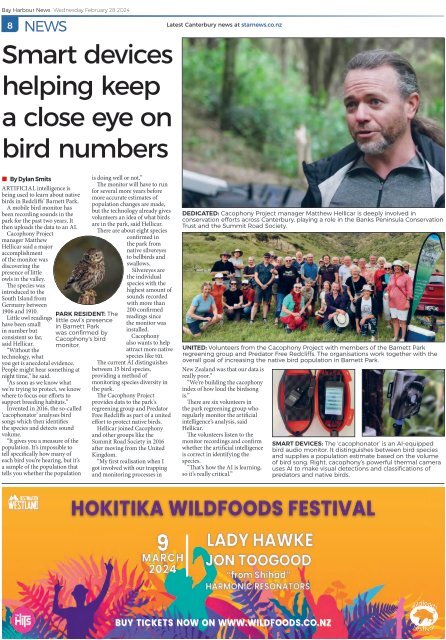Bay Harbour: February 28, 2024
Create successful ePaper yourself
Turn your PDF publications into a flip-book with our unique Google optimized e-Paper software.
<strong>Bay</strong> <strong>Harbour</strong> News Wednesday <strong>February</strong> <strong>28</strong> <strong>2024</strong><br />
8<br />
NEWS<br />
Latest Canterbury news at starnews.co.nz<br />
Smart devices<br />
helping keep<br />
a close eye on<br />
bird numbers<br />
• By Dylan Smits<br />
ARTIFICIAL intelligence is<br />
being used to learn about native<br />
birds in Redcliffs’ Barnett Park.<br />
A mobile bird monitor has<br />
been recording sounds in the<br />
park for the past two years. It<br />
then uploads the data to an AI.<br />
Cacophony Project<br />
manager Matthew<br />
Hellicar said a major<br />
accomplishment<br />
of the monitor was<br />
discovering the<br />
presence of little<br />
owls in the valley.<br />
The species was<br />
introduced to the<br />
South Island from<br />
Germany between<br />
1906 and 1910.<br />
Little owl readings<br />
have been small<br />
in number but<br />
consistent so far,<br />
said Hellicar.<br />
“Without the<br />
technology, what<br />
you get is anecdotal evidence.<br />
People might hear something at<br />
night time,” he said.<br />
“As soon as we know what<br />
we’re trying to protect, we know<br />
where to focus our efforts to<br />
support breeding habitats.”<br />
Invented in 2016, the so-called<br />
‘cacophonator’ analyses bird<br />
songs which then identifies<br />
the species and detects sound<br />
volume.<br />
“It gives you a measure of the<br />
population. It’s impossible to<br />
tell specifically how many of<br />
each bird you’re hearing, but it’s<br />
a sample of the population that<br />
tells you whether the population<br />
PARK RESIDENT: The<br />
little owl’s presence<br />
in Barnett Park<br />
was confirmed by<br />
Cacophony’s bird<br />
monitor.<br />
is doing well or not.”<br />
The monitor will have to run<br />
for several more years before<br />
more accurate estimates of<br />
population changes are made,<br />
but the technology already gives<br />
volunteers an idea of what birds<br />
are in the park, said Hellicar.<br />
There are about eight species<br />
confirmed in<br />
the park from<br />
native silvereyes<br />
to bellbirds and<br />
swallows.<br />
Silvereyes are<br />
the individual<br />
species with the<br />
highest amount of<br />
sounds recorded<br />
with more than<br />
200 confirmed<br />
readings since<br />
the monitor was<br />
installed.<br />
Cacophony<br />
also wants to help<br />
attract more native<br />
species like tūī.<br />
The current AI distinguishes<br />
between 15 bird species,<br />
providing a method of<br />
monitoring species diversity in<br />
the park.<br />
The Cacophony Project<br />
provides data to the park’s<br />
regreening group and Predator<br />
Free Redcliffs as part of a united<br />
effort to protect native birds.<br />
Hellicar joined Cacophony<br />
and other groups like the<br />
Summit Road Society in 2016<br />
after moving from the United<br />
Kingdom.<br />
“My first realisation when I<br />
got involved with our trapping<br />
and monitoring processes in<br />
DEDICATED: Cacophony Project manager Matthew Hellicar is deeply involved in<br />
conservation efforts across Canterbury, playing a role in the Banks Peninsula Conservation<br />
Trust and the Summit Road Society.<br />
UNITED: Volunteers from the Cacophony Project with members of the Barnett Park<br />
regreening group and Predator Free Redcliffs. The organisations work together with the<br />
overall goal of increasing the native bird population in Barnett Park.<br />
New Zealand was that our data is<br />
really poor.”<br />
“We’re building the cacophony<br />
index of how loud the birdsong<br />
is.”<br />
There are six volunteers in<br />
the park regreening group who<br />
regularly monitor the artificial<br />
intelligence’s analysis, said<br />
Hellicar.<br />
The volunteers listen to the<br />
monitor recordings and confirm<br />
whether the artificial intelligence<br />
is correct in identifying the<br />
species.<br />
“That’s how the AI is learning,<br />
so it’s really critical.”<br />
SMART DEVICES: The ‘cacophonator’ is an AI-equipped<br />
bird audio monitor. It distinguishes between bird species<br />
and supplies a population estimate based on the volume<br />
of bird song. Right, cacophony’s powerful thermal camera<br />
uses AI to make visual detections and classifications of<br />
predators and native birds.<br />
BUY TICKETS NOW ON WWW.WILDFOODS.CO.NZ


















